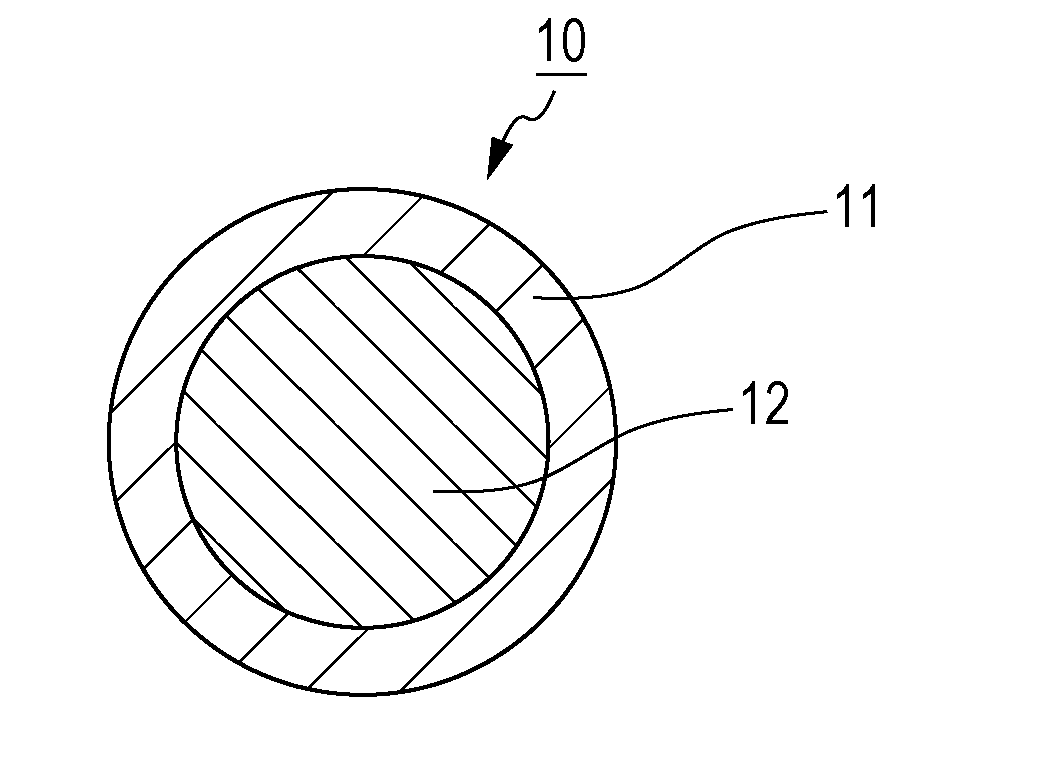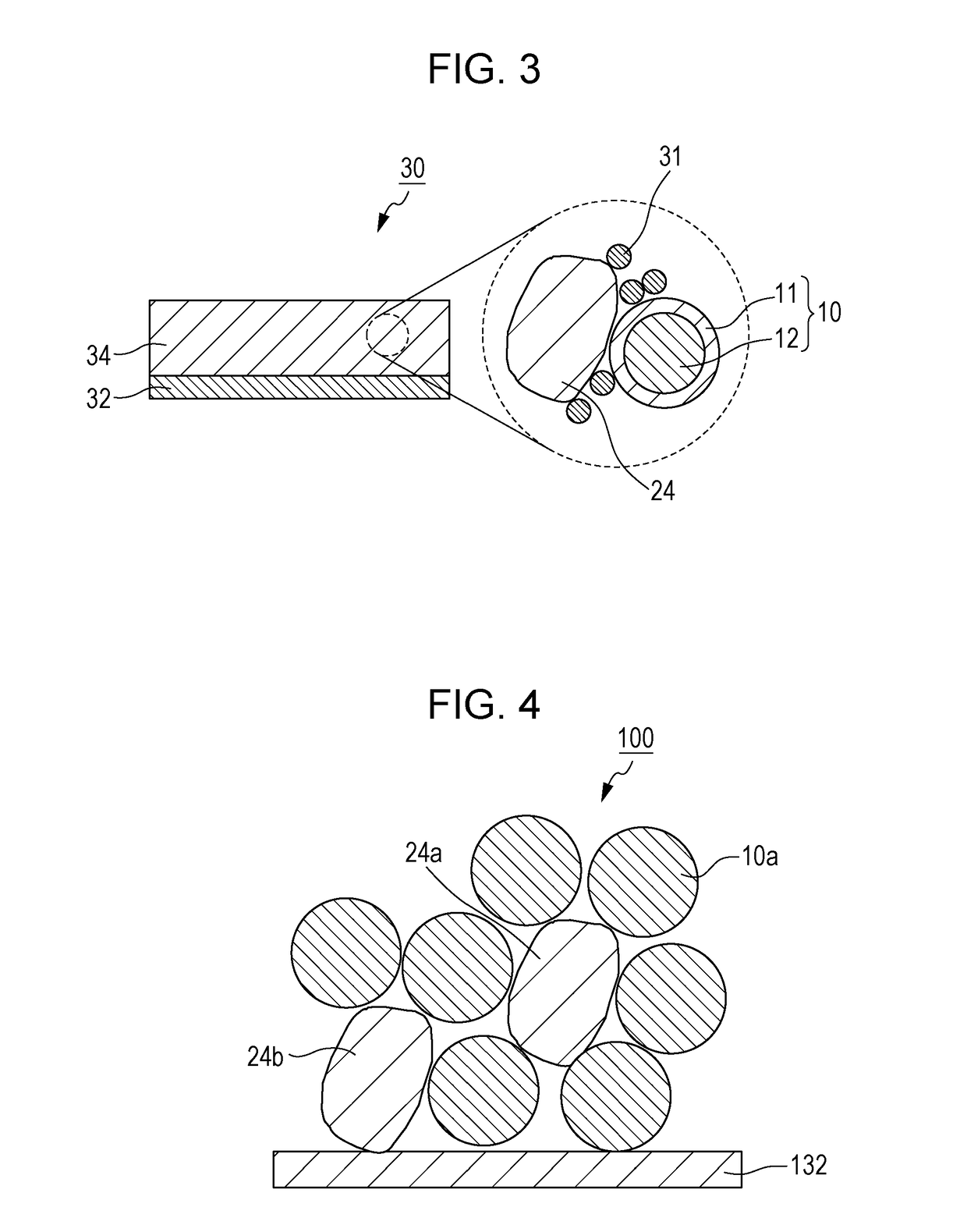Solid electrolyte material including sulfide layer and oxide layer, and battery including the solid electrolyte material
a solid electrolyte and oxide layer technology, applied in the direction of electrolytes, cell components, electrical equipment, etc., can solve the problem of difficult to drive a solid-state battery that includes an organic solid electrolyte at room temperatur
- Summary
- Abstract
- Description
- Claims
- Application Information
AI Technical Summary
Benefits of technology
Problems solved by technology
Method used
Image
Examples
embodiment 1
[0070]A sulfide solid electrolyte material 10 according to Embodiment 1 includes an oxide layer 11 and a sulfide layer 12 as illustrated in FIG. 1. The sulfide layer 12 is a layer including a sulfide material. The oxide layer 11 is a layer including an oxide of the sulfide material included in the sulfide layer 12. The oxide layer 11 is disposed on the surface of the sulfide layer 12. The sulfide solid electrolyte material 10 according to Embodiment 1 has a core shell structure, in which the sulfide layer 12 serves as a core and the oxide layer 11 serves as a shell. Hereinafter, the sulfide solid electrolyte material 10 is referred to simply as “electrolyte material 10”.
[0071]The electrolyte material 10 satisfies 0.51≤x and x / y≥1.53, where x is the ratio (B / A) of the number of oxygen atoms (B) to the number of lithium atoms (A) which is determined by X-ray photoelectron spectroscopy (XPS) analysis at a depth 4 nm from the surface of the oxide layer 11, and y is the ratio (b / a) of th...
embodiment 2
[0097]A battery 20 according to Embodiment 2 includes a positive electrode 21, a negative electrode 23, and an electrolyte layer 22 as illustrated in FIG. 2. The positive electrode 21 includes a positive electrode active material particle 24 and the electrolyte material 10. The electrolyte layer 22 is interposed between the positive electrode 21 and the negative electrode 23. The electrolyte layer 22 is in contact with both of the positive electrode 21 and the negative electrode 23. The electrolyte layer 22 includes an electrolyte material, such as a solid electrolyte material. The negative electrode 23 includes a negative electrode active material particle 25 and the electrolyte material 10. In the battery 20 according to Embodiment 2, the extraction of lithium at the contact interface between the electrolyte material 10 and the positive electrode active material particle 24 may be reduced. Consequently, the battery 20 may have an excellent discharge characteristic.
[0098]The positi...
embodiment 3
[0125]Since a sulfide solid electrolyte material does not include an organic solvent that becomes decomposed at high potentials in contrast to organic electrolyte solutions, a sulfide solid electrolyte material has a wide potential window. That is, it is considered that a sulfide solid electrolyte material is stable in terms of potential and resistant to decomposition by oxidation. However, as a result of extensive studies, the inventor of the present invention found that a trace amount of lithium may be extracted from a sulfide solid electrolyte material, that is, a sulfide solid electrolyte material may become oxidized, at high potentials. The inventor of the present invention also found that, in the case where the positive electrode includes a conductive additive, the extraction of lithium from a sulfide solid electrolyte material may result in a reduction in the charge / discharge efficiency of a battery.
[0126]A positive electrode 30 according to Embodiment 3 includes the electrol...
PUM
| Property | Measurement | Unit |
|---|---|---|
| ionic conductivities | aaaaa | aaaaa |
| median diameter | aaaaa | aaaaa |
| median diameter | aaaaa | aaaaa |
Abstract
Description
Claims
Application Information
 Login to View More
Login to View More - R&D
- Intellectual Property
- Life Sciences
- Materials
- Tech Scout
- Unparalleled Data Quality
- Higher Quality Content
- 60% Fewer Hallucinations
Browse by: Latest US Patents, China's latest patents, Technical Efficacy Thesaurus, Application Domain, Technology Topic, Popular Technical Reports.
© 2025 PatSnap. All rights reserved.Legal|Privacy policy|Modern Slavery Act Transparency Statement|Sitemap|About US| Contact US: help@patsnap.com



